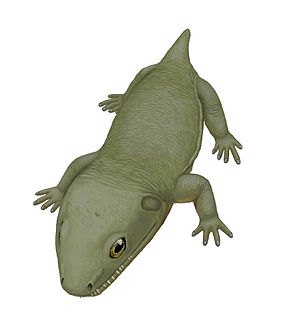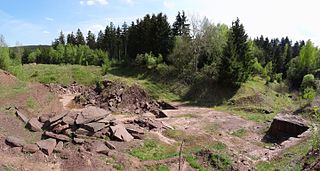
Seymouria is an extinct genus of seymouriamorph from the Early Permian of North America and Europe. Although they were amphibians, Seymouria were well-adapted to life on land, with many reptilian features—so many, in fact, that Seymouria was first thought to be a primitive reptile. It is primarily known from two species, Seymouria baylorensis and Seymouria sanjuanensis. The type species, S. baylorensis, is more robust and specialized, though its fossils have only been found in Texas. On the other hand, Seymouria sanjuanensis is more abundant and widespread. This smaller species is known from multiple well-preserved fossils, including a block of six skeletons found in the Cutler Formation of New Mexico, and a pair of fully grown skeletons from the Tambach Formation of Germany, which were fossilized lying next to each other.

Caseasauria is one of the two main clades of early synapsids, the other being the Eupelycosauria. Caseasaurs are currently known only from the Late Carboniferous and the Permian, and include two superficially different families, the small insectivorous or carnivorous Eothyrididae, and the large, herbivorous Caseidae. These two groups share a number of specialised features associated with the morphology of the snout and external naris.
Varanopidae is an extinct family of amniotes that resembled monitor lizards and may have filled a similar niche, hence the name. Typically, they are considered synapsids that evolved from an Archaeothyris-like synapsid in the Late Carboniferous. However, some recent studies have recovered them being taxonomically closer to diapsid reptiles. A varanopid from the latest Middle Permian Pristerognathus Assemblage Zone is the youngest known varanopid and the last member of the "pelycosaur" group of synapsids.

Oedaleops is an extinct genus of caseasaur synapsids from the Early Permian of the southwestern United States. Fossils have been found in the Cutler Formation in New Mexico, which dates back to the Wolfcampian stage of the Early Permian. All remains belong to the single known species Oedaleops campi. Oedaleops was closely related to Eothyris, and both are part of the family Eothyrididae. Like Eothyris, it was probably an insectivore.

Eudibamus is an extinct genus of biped bolosaurid ankyramorph parareptile known from the Free State of Thuringia of central Germany. It had a very small size reaching only 25-26 cm in length.

Trematopidae is a family of dissorophoid temnospondyl spanning the late Carboniferous to the early Permian. Together with Dissorophidae, the family forms Olsoniformes, a clade comprising the medium-large terrestrial dissorophoids. Trematopids are known from numerous localities in North America, primarily in New Mexico, Oklahoma, and Texas, and from the Bromacker quarry in Germany.

Anconastes is an extinct genus of dissorophoid temnospondyl within the family Trematopidae. It is known from two specimens from the Late Carboniferous Cutler Formation of north-central New Mexico in the southwestern United States. The genus name derives from two Greek roots, ankos and nastes ("inhabitant"), which refers to the type locality of El Cobre Canyon where the specimens were found. The specific name is derived from the Latin word vesperus ("western"). The more complete specimen, the holotype, is a partial skull with articulated mandibles and a substantial amount of the postcranial skeleton. The less complete specimen, the paratype, consists only of the right margin of the skull with an articulated mandible.
Actiobates is an extinct genus of trematopid temnospondyl that lived during the Late Carboniferous. It is known from the Garnett Quarry in Kansas.

Tambachia is an extinct genus of dissorophoid temnospondyl within the family Trematopidae. It is known from the Early Permian Tambach Formation near the town of Tambach-Dietharz in Thuringia, Germany. Tambachia is the first trematopid to have been discovered outside the United States.

Ostodolepidae, also spelled Ostodolepididae, is an extinct family of Early Permian microsaurs. They are unique among microsaurs in that they were large, reaching lengths of up to 2 feet (61 cm), terrestrial, and presumably fossorial. Ostodolepid remains have been found from Early Permian beds in Texas, Oklahoma, and Germany.
Paleontology or palaeontology is the study of prehistoric life forms on Earth through the examination of plant and animal fossils. This includes the study of body fossils, tracks (ichnites), burrows, cast-off parts, fossilised feces (coprolites), palynomorphs and chemical residues. Because humans have encountered fossils for millennia, paleontology has a long history both before and after becoming formalized as a science. This article records significant discoveries and events related to paleontology that occurred or were published in the year 2011.
Georgenthalia is an extinct genus of dissorophoid temnospondyl from the Lower Permian. It is an amphibamid which lived in what is now the Thuringian Forest of central Germany. It is known from the holotype MNG 11135, a small, complete skull. It was found in the Bromacker locality of the Tambach Formation. It was first named by Jason S. Anderson, Amy C. Henrici, Stuart S. Sumida, Thomas Martens and David S. Berman in 2008 and the type species is Georgenthalia clavinasica.

Olsoniformes is a clade of dissorophoid temnospondyls. It includes the families Dissorophidae and Trematopidae. Most members of the clade were highly adapted to a terrestrial lifestyle. The clade was named in 2008 and is defined as the least inclusive clade containing Dissorophus multicinctus and Acheloma cumminsi but not Amphibamus grandiceps, Micromelerpeton credneri, and Apateon pedestris. Olsoniforms share various features such as a stout and low ilium and a thin cultriform process.
Tambaroter is an extinct genus of ostodolepid microsaur from the Early Permian of Germany. The type species T. carrolli was named in 2011. Tambaroter is known from a single skull found in the Tambach Formation, which is the lowermost unit of the Upper Rotliegend. It is the only vertebrate that has been found outside the Bromacker Quarry, the most productive locality of the formation. It is also the first ostodolepid known from outside North America.
Thuringothyris is an extinct genus of Early Permian eureptiles known from the Thuringian Forest in central Germany.

Rotaryus is an extinct genus of Early Permian trematopid dissorophoid temnospondyl known from the Free State of Thuringia of central Germany.

The Tambach Formation is an Early Permian-age geologic formation in central Germany. It consists of red to brown-colored sedimentary rocks such as conglomerate, sandstone, and mudstone, and is the oldest portion of the Upper Rotliegend within the Thuringian Forest Basin.

Eucacopinae is an extinct clade of dissorophid temnospondyls. Eucacopines differ from the other main group of dissorophids, the Dissorophinae, in having more lightly built skeletons and more knobby skulls. The subfamily was originally named Cacopinae, but since the name was already established for a group of living microhylid frogs in 1931, the name was changed to Eucacopinae in 2013. Eucacopinae is a stem-based taxon defined as the most inclusive clade containing the species Cacops apsidephorus but not Dissorophus multicinctus, which belongs to Dissorophinae. According to the most recent phylogenetic analyses of Dissorophidae, Eucacopinae includes the basal ("primitive") species Conjunctio multidens and Scapanops neglecta from the southwestern United States and a more derived ("advanced") group including several species of Cacops and the Russian genera Kamacops and Zygosaurus. Derived eucacopines have two rows of bony plates called osteoderms running down their backs, while the more basal eucacopines have only a single row. Dissorophines also have a double row of osteoderms but probably evolved them independently because the most recent common ancestor of the two groups had a single row of osteoderms.
Martensius is an extinct genus of caseid synapsid from the Early Permian of Germany. The type species is Martensius bromackerensis.















